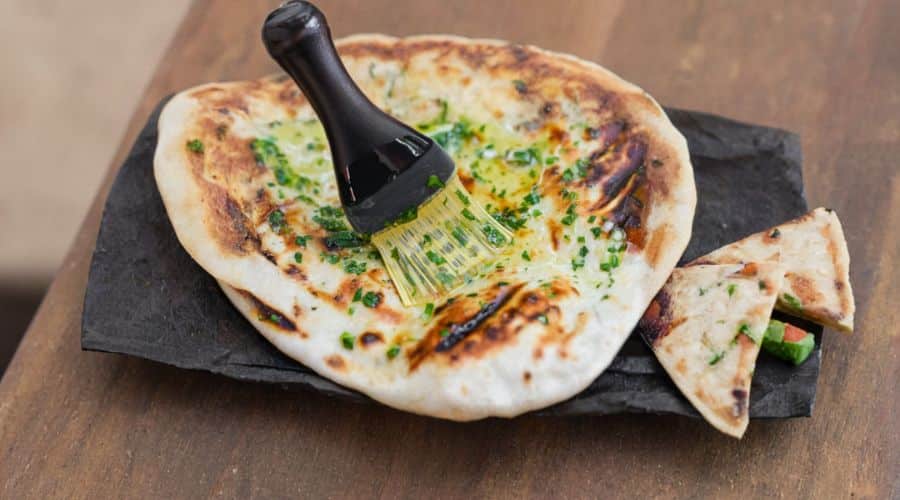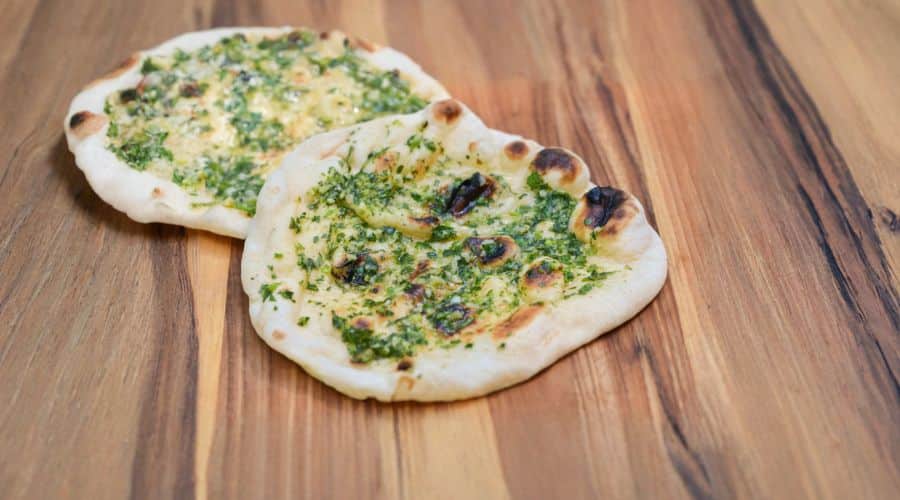This Garlic and Herb Grilled Flatbread stands out for its delightful combination of fresh herbs, smoky grill marks, and a soft yet chewy texture.
Made with yogurt or whole milk, the dough delivers a subtle tang and tender crumb without relying on heavy fats, while the garlic-herb butter enriches each bite with vibrant flavor and nourishing fats.

The flatbread offers a balanced nutritional profile—rich in plant-based protein from the flour and yogurt, along with healthy monounsaturated fats from olive oil and butter.
This recipe is both satisfying and approachable, making it perfect for everyday meals or quick entertaining. It’s versatile enough to accompany main dishes, serve as a snack, or act as a base for toppings.
Plus, the grill method adds an appealing char and aroma that oven baking can’t replicate, elevating a simple bread into a memorable treat.
Must-Have Tools for Perfect Results
Stand Mixer with Dough Hook
Essential for effortlessly combining and kneading the dough to the perfect consistency, saving time and ensuring even mixing. Beyond this recipe, it’s invaluable for all your baking projects, from bread to cakes.
Cast Iron Skillet
Perfect for roasting garlic to deepen its flavor and develop a sweet, mellow aroma. A cast iron skillet is a versatile kitchen staple that retains heat well, ideal for searing, frying, and slow cooking.
Charcoal Grill with Chimney Starter
The secret to achieving authentic grill marks and smoky flavor on the flatbread. A chimney starter ensures quick, even charcoal ignition, making outdoor cooking easier and more efficient.
Rolling Pin
Used to roll dough evenly into perfect circles for consistent cooking. This classic tool is essential for everything from pastry to pizza dough preparation.
Basting Brush
Ideal for evenly applying the garlic-herb butter onto the hot flatbread, locking in flavor and moisture. A kitchen must-have for glazing, basting, and spreading sauces with precision.

Grilled Garlic Scallion Flatbread
Equipment
- 1 Stand mixer with dough hook
- Cast iron skillet
- 1 Charcoal grill with chimney starter
- 1 Rolling Pin
- 1 Basting brush
Ingredients
For the Flatbread:
- 10 oz bread flour about 2 cups
- 2 tsp sugar
- 1 tsp kosher salt
- ½ tsp instant or rapid-rise yeast
- 6.5 oz yogurt or whole milk about ¾ cup plus 1 tbsp
- 2 tbsp extra-virgin olive oil
For the Garlic-Herb Butter:
- 6 medium garlic cloves unpeeled
- 4 tbsp butter melted
- 2 tbsp fresh parsley finely minced
- 2 tbsp fresh cilantro finely minced
- 2 tbsp scallions finely minced
Instructions
- Preparing the Dough Ingredients: Begin by gathering all your dry ingredients for the flatbread dough. In the bowl of a stand mixer fitted with a dough hook attachment, combine 10 ounces of bread flour, 2 teaspoons of sugar, 1 teaspoon of kosher salt, and ½ teaspoon of instant or rapid-rise yeast. Whisk these ingredients together briefly to ensure they are evenly distributed. This initial step guarantees that the yeast will activate uniformly and the dough will rise consistently.
- Mixing Wet Ingredients into Dough: Next, add 6½ ounces of either plain yogurt or whole milk into the dry mixture. Pour in 2 tablespoons of extra-virgin olive oil as well. Start mixing the ingredients on low speed to bring the dough together. Keep the mixer running until the dough forms a sticky mass that clings slightly to the bottom of the bowl. If the dough feels too dry and doesn’t stick well, add an extra tablespoon of yogurt or milk at a time until you achieve the right tackiness.
- Kneading the Dough for Gluten Development: Once the dough begins to come together, increase the mixer speed to medium-high and knead the dough for about 5 minutes. This process develops the gluten network, which will give the flatbread its signature chewy texture. You’ll notice the dough becoming smoother and more elastic as you knead. After kneading, turn the dough out onto a lightly floured surface and knead it a few more times by hand, shaping it into a smooth, cohesive ball.
- First Dough Rise: Letting the Dough Double: Place your dough ball into a large bowl, ensuring it’s lightly oiled or dusted with flour to prevent sticking. Cover the bowl tightly with plastic wrap or a clean kitchen towel. Let the dough rise at room temperature until it doubles in size, which should take approximately 2 hours. This slow fermentation allows the yeast to work, creating air bubbles that make the bread tender and airy.
- Dividing and Shaping Dough Portions: After the dough has doubled, gently turn it out onto a floured work surface. Using a sharp knife or bench scraper, divide the dough into six equal portions. Roll each portion into a smooth ball by cupping your hands around the dough and gently rotating it on the surface. Place the dough balls onto a baking sheet or another floured surface. Cover them again with plastic wrap or a damp cloth, allowing them to rise and puff up further for another 2 hours at room temperature.
- Roasting Garlic for Herb Butter: While the dough undergoes its second rise, prepare the flavorful garlic-herb butter. Place six unpeeled garlic cloves in a small cast iron skillet over medium-high heat. Roast the garlic until fragrant and golden with some darkened spots, about 8 minutes. This roasting mellows the garlic’s sharpness and adds a rich, caramelized flavor. Once cooked, transfer the garlic to a cutting board and let it cool until safe to handle. Peel off the skins and finely mince the roasted garlic.
- Combining Garlic and Herbs into Butter: In a small mixing bowl, combine the minced roasted garlic with 4 tablespoons of melted butter. Add 2 tablespoons each of finely chopped fresh parsley, fresh cilantro, and scallions. Stir everything together thoroughly until well incorporated. This fragrant butter will infuse your grilled flatbread with bright, herbaceous notes and a creamy texture.
- Preparing the Grill for Cooking Flatbreads: To achieve authentic grill marks and smoky flavor, prepare your charcoal grill. Fill a chimney starter with charcoal and light it. When the charcoal is fully ignited and covered with gray ash, carefully pour the coals onto one side of the grill’s charcoal grate to create a two-zone fire (one hot side and one cooler side). Place the cooking grate on top and cover the grill, allowing it to preheat for about 5 minutes. Clean the grill grate thoroughly and oil it lightly to prevent the dough from sticking.
- Rolling Dough into Flat Circles: On a floured surface, take each dough ball and roll it out evenly into a circle approximately 8 inches in diameter. Use gentle, even pressure with your rolling pin, rotating the dough occasionally to maintain a round shape. Make sure the dough is not too thin to avoid tearing during grilling, but thin enough to cook through quickly.
- Grilling the Flatbreads: Place one or two rolled-out dough rounds onto the hot side of the grill. Cook the flatbreads until the bottoms develop golden brown spots and light char marks, usually about 1-2 minutes. Carefully flip each flatbread and grill the second side until it also has browned, slightly charred spots, another 1-2 minutes. Be attentive to avoid burning and adjust placement as needed.
- Applying Garlic-Herb Butter and Serving: After grilling, transfer the flatbreads to the cooler side of the grill. Using a basting brush, generously brush the hot breads with the prepared garlic-herb butter, allowing the butter to melt into the surface and enhance the flavor. Transfer the buttered flatbreads onto a cutting board and slice each into six equal wedges. Serve immediately while warm and aromatic for the best taste and texture.
Notes
Chef’s Secrets: Unlocking Maximum Flavor
The key to truly outstanding grilled flatbread lies in balancing simple ingredients with careful technique.
Roasting the garlic rather than using it raw softens its pungency and brings out a caramelized sweetness that beautifully complements the fresh herbs.
Kneading the dough thoroughly with a stand mixer helps develop the gluten network, producing a chewy yet tender bite.
When rolling out the dough, aim for an even thickness to guarantee uniform cooking and prevent soggy spots.
Lastly, grilling over a two-zone fire allows you to cook the bread quickly on the hot side, then finish it on the cooler side while brushing with herb butter—locking in moisture and flavor.
Serving Suggestions: Pairings to Impress Guests
This flatbread makes an excellent accompaniment to a variety of dishes.
Serve it alongside grilled meats like chicken kebabs, lamb chops, or fish for a Mediterranean-inspired meal.
It also works well as a base for toppings—try adding hummus, roasted vegetables, or feta cheese for a quick appetizer. For a casual snack, slice the flatbread and serve with a side of tzatziki or olive tapenade.
Its warm, buttery, and herbaceous notes make it a perfect partner for fresh salads or hearty stews, bringing texture and flavor to the plate.
Storage Tips: Keep Flatbread Fresh Longer
To store leftover flatbread, allow it to cool completely before wrapping tightly in plastic wrap or placing in an airtight container.
It will keep well at room temperature for up to two days.
For longer storage, freeze the flatbreads separated by parchment paper in a freezer-safe bag for up to one month.
To reheat, warm them briefly on a grill or skillet to revive the crisp exterior and soft interior.
Avoid microwaving, as it can cause the bread to become rubbery or soggy.
Brushing with a little extra garlic-herb butter after reheating will bring back the fresh flavor.
Frequently Asked Questions: Common Recipe Clarifications
1. Can I use all-purpose flour instead of bread flour?
Yes, all-purpose flour can be substituted, but the texture will be slightly less chewy and elastic because bread flour has a higher protein content which develops more gluten.
2. What can I substitute for yogurt or milk in the dough?
You can use buttermilk or even a dairy-free alternative like unsweetened almond milk for a similar tender dough. Keep in mind this may affect flavor and texture slightly.
3. Is it possible to make this flatbread without a grill?
Absolutely! You can cook the flatbreads in a hot cast iron skillet or on a grill pan over medium-high heat to achieve a similar char and texture indoors.
4. How do I prevent the flatbread from sticking to the grill?
Make sure to oil the grill grate well before placing the dough down. Also, ensure the grill is properly preheated, which helps the bread release easily once it’s ready to flip.
5. Can I prepare the dough in advance?
Yes, you can prepare the dough up to the first rise, then refrigerate it overnight. Bring it to room temperature before dividing and proceeding with the second rise to maintain proper texture.
This recipe is inspired by meatwave and has been carefully refined to enhance clarity, streamline preparation steps, and ensure accurate results. We’ve also included health benefits, nutritional highlights, and Must-Have Tools to help you get the best results every time you cook.


